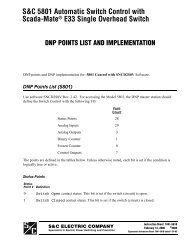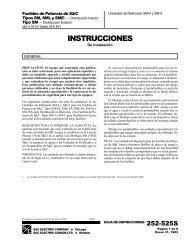Specification Bulletin 682-31 - S&C Electric Company
Specification Bulletin 682-31 - S&C Electric Company
Specification Bulletin 682-31 - S&C Electric Company
Create successful ePaper yourself
Turn your PDF publications into a flip-book with our unique Google optimized e-Paper software.
S&C Remote Supervisory Vista® Underground Distribution SwitchgearPotential Indication with Test FeatureWhen this optional voltage indication is specified, allroutine operating tasks—switching, voltage testing, andgrounding—can be accomplished by a single person withoutcable handling or exposure to medium voltage. This featureis available with or without provisions for low-voltagephasing. Cable testing for faults can be performed throughthe back of a user-supplied elbow or through a user-suppliedfeedthru insert, eliminating the need for cable handling oruse of parking stands.EXCLUSIONS: The purchaser must specify the switchgearstyle, communication and control equipment, motoroperator package, and any desired optional features tocomplete the catalog number of the switchgear.Communication devices, when specified, do not includeantenna, antenna support, surge protection, or coaxialfeedline. Propagation study, frequency selection, and FCClicense application are also to be provided by others.WARRANTY QUALIFICATIONS: The standard warrantycontained in seller’s standard conditions of sale (as set forthin Price Sheet 150) does not apply to major componentsnot of S&C manufacture, such as remote terminal unitsand communication devices, including hardware, software,resolution of protocol-related matters, and notification ofupgrades or fixes for those devices.Seller’s standard warranty does not apply to anycomponents not of S&C manufacture that are suppliedand installed by the purchaser, nor to the ability of seller’sequipment to work with such components.APPLICATION NOTES: Fault Interrupter—Completeratings for the fault interrupter are shown in the table onpage 4. In addition to the load-dropping ratings shown,the fault interrupter is capable of interrupting transformermagnetizing currents associated with the applicable loads,as well as line-charging and cable-charging currents typicalfor distribution systems of these voltage ratings.The duty-cycle fault-closing rating and ten-timeduty-cycle fault-interrupting rating shown for the faultinterrupter define, respectively, the level of availablethree-phase fault current into which the fault interrupter canbe closed the designated number of times in the “closed” or“grounded” position and subsequently interrupt, with thefault interrupter remaining operable and able to interruptrated continuous current.A Note on Single-Pole SwitchingIn single-pole switching of ungrounded-primary three-phasetransformers or banks (or single-phase transformersconnected line-to-line), circuit connections or parametersmay, in some cases, produce excessive overvoltages. Inparticular, for the following applications above 22 kV,single-pole switching should be performed only under theconditions stated in italics:• Switching unloaded or lightly loaded delta-connectedor ungrounded-primary wye-wye connected three-phasetransformers or banks (or line-to-line connected singlephasetransformers), rated 150 kVA or less three-phase,or 50 kVA or less single-phase—or of any kVA rating whencombined with unloaded cables or lines—where maximumsystem operating voltage exceeds 22 kV. Singlepoleswitching should be performed only if each phaseis carrying 5% load or more, or if the transformer orbank is temporarily grounded at the primary neutralduring switching.• Switching loaded or unloaded ungrounded-primary wyedeltaconnected three-phase transformers or banks—alone or combined with unloaded cables or lines—wheremaximum system operating voltage exceeds 22 kV.Single-pole switching should be performed only if eachphase is carrying 5% load or more and if the lightingloadphase is always switched open first (or switchedclosed last); or if the transformer or bank is temporarilygrounded at the primary neutral during switching.Load-Interrupter Switch—Complete ratings for theload-interrupter switch are shown in the table onpage 4. In addition to the load-dropping ratings shown,the load-interrupter switch is capable of interruptingtransformer magnetizing currents associated with theapplicable loads, as well as line-charging and cable-chargingcurrents typical for distribution systems of these voltageratings. For applications involving load current with highharmonic content (such as rectifier load currents), refer tothe nearest S&C Sales Office.The duty-cycle fault-closing rating shown for theload-interrupter switch defines the level of availablethree-phase fault current into which the load-interrupterswitch can be closed the designated number of times in the“closed” or “grounded” position, with the load-interrupterswitch remaining operable and able to interrupt ratedcontinuous current.S&C <strong>Specification</strong> <strong>Bulletin</strong> <strong>682</strong>-<strong>31</strong> 3


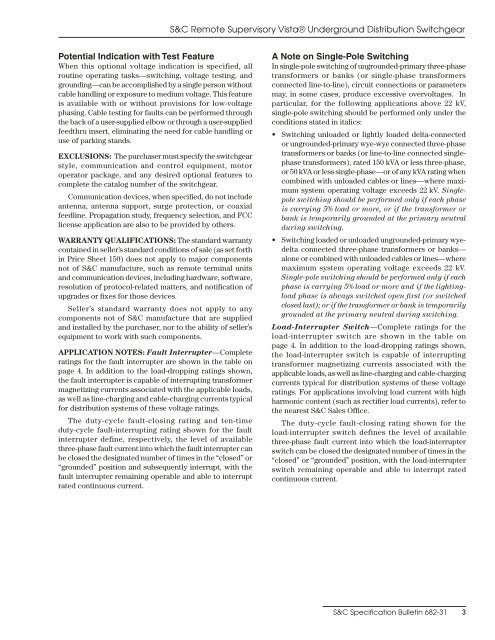
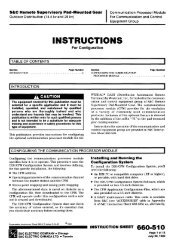
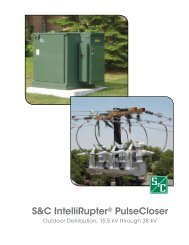
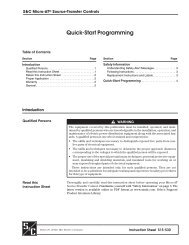
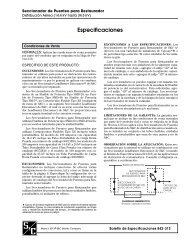


![Boletin Descriptivo 851-30S [Spanish, 3 MB, 12/20/2004]](https://img.yumpu.com/49573007/1/190x245/boletin-descriptivo-851-30s-spanish-3-mb-12-20-2004.jpg?quality=85)
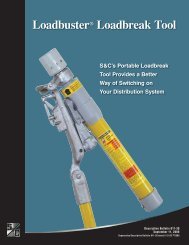
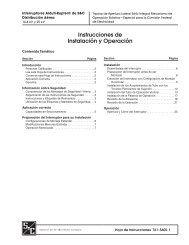
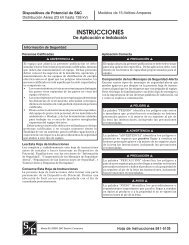
![Boletin de Especificaciones 771-31S [Spanish, 2 MB, 8/30/2010]](https://img.yumpu.com/48742025/1/190x245/boletin-de-especificaciones-771-31s-spanish-2-mb-8-30-2010.jpg?quality=85)
